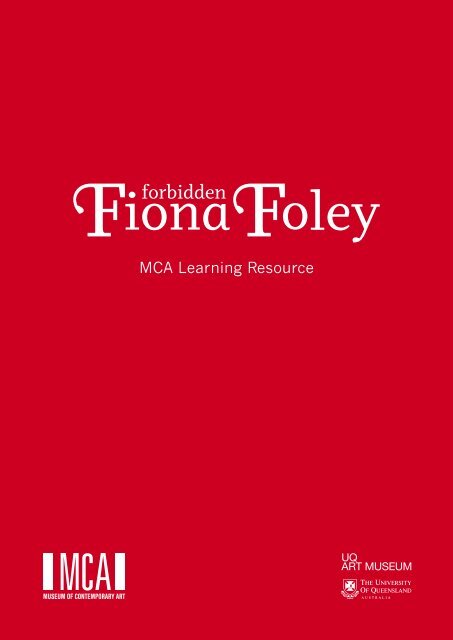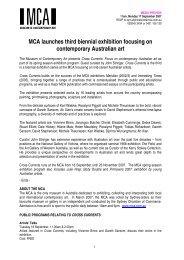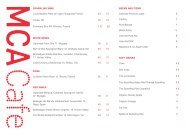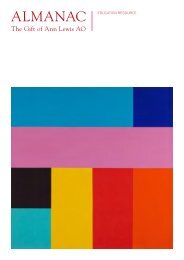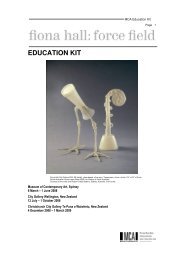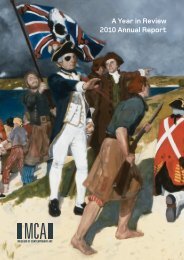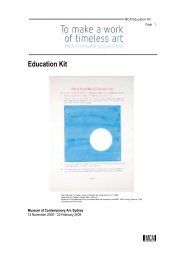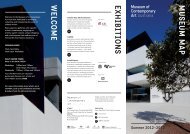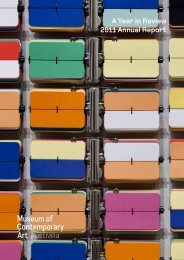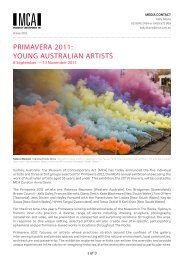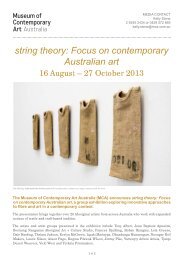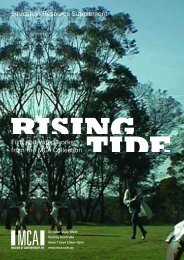Fiona Foley - UQ Art Museum - University of Queensland
Fiona Foley - UQ Art Museum - University of Queensland
Fiona Foley - UQ Art Museum - University of Queensland
Create successful ePaper yourself
Turn your PDF publications into a flip-book with our unique Google optimized e-Paper software.
MCA Learning Resource<br />
1
Contents<br />
Curriculum connections<br />
Purpose <strong>of</strong> this resource<br />
<strong>Fiona</strong> <strong>Foley</strong> – biography<br />
Overview <strong>of</strong> the exhibition<br />
Key themes in the exhibition:<br />
1. History and memory<br />
• History <strong>of</strong> Fraser Island p.7 •<br />
• Colonisation p.8 •<br />
2. Politics and cultural identity<br />
• Visibility p.16 •<br />
• Inverting racism p.18 •<br />
• Representation and colonial sexuality p.20 •<br />
• Performance and ethnology p.22 •<br />
• Racial relations p.25 •<br />
• Cultural remix p.29 •<br />
Glossary p.32<br />
References p.33<br />
Acknowledgements p.34
Curriculum Connections<br />
Visual <strong>Art</strong>s/Creative <strong>Art</strong>s<br />
Contemporary Australian <strong>Art</strong><br />
The role <strong>of</strong> the curator<br />
The role <strong>of</strong> the contemporary museum<br />
<strong>Art</strong> history<br />
The frames<br />
The conceptual framework<br />
<strong>Art</strong>ist’s practice<br />
Body <strong>of</strong> work<br />
Tracing the career <strong>of</strong> artists<br />
Diversity <strong>of</strong> media and practice<br />
English<br />
Analysing visual texts<br />
Oral and research skills<br />
Creative writing<br />
Critical essays and reviews<br />
Photographic and Digital Media<br />
The moving image – video and installation<br />
Society and Environment<br />
Visual arts as a reflection <strong>of</strong> contemporary culture<br />
The influence <strong>of</strong> history on creative practice<br />
Visual arts as a reflection <strong>of</strong> cultural and personal identity<br />
ESL/NESB/CALD<br />
Developing a visual arts vocabulary<br />
Oral and written responses<br />
Cultural identity and other issues in the visual arts<br />
3
Purpose <strong>of</strong> this Resource<br />
This Education Resource is designed to give secondary teachers an overview<br />
<strong>of</strong> the exhibition <strong>Fiona</strong> <strong>Foley</strong>: Forbidden. This presentation is the artist’s most<br />
substantial exhibition to date, and represents an institutional partnership<br />
between the <strong>Museum</strong> <strong>of</strong> Contemporary <strong>Art</strong>, Sydney and The <strong>University</strong> <strong>of</strong><br />
<strong>Queensland</strong> <strong>Art</strong> <strong>Museum</strong>, Brisbane. It will be presented on the MCA’s Level 4<br />
galleries from 12 November 2009 until 31 January 2010, and at <strong>UQ</strong> <strong>Art</strong> <strong>Museum</strong><br />
from 19 February to 2 May 2010. It provides teachers with a comprehensive<br />
introduction to the artist and her work, and includes focus questions for critical<br />
analysis and practical ideas for class-based art making.<br />
A glossary and list <strong>of</strong> references are included to enable further research into<br />
<strong>Foley</strong>’s artistic development. Words in bold can be found in the glossary at the<br />
end <strong>of</strong> the resource.<br />
<strong>Fiona</strong> <strong>Foley</strong> - Biography<br />
<strong>Fiona</strong> <strong>Foley</strong> was born in Maryborough, <strong>Queensland</strong>, in 1964 and grew up in<br />
Hervey Bay and Sydney. <strong>Foley</strong> obtained a Certificate <strong>of</strong> <strong>Art</strong>s at East Sydney<br />
Technical College in 1983. In 1986 she received a Bachelor <strong>of</strong> Visual <strong>Art</strong>s<br />
from the Sydney College <strong>of</strong> the <strong>Art</strong>s, and 1987 a Diploma <strong>of</strong> Education at the<br />
<strong>University</strong> <strong>of</strong> Sydney.<br />
In 1987 she co-founded the Boomalli Aboriginal <strong>Art</strong>ists Co-operative in Sydney,<br />
along with fellow urban-based artists Avril Quaill, Michael Riley, Tracey M<strong>of</strong>fatt,<br />
Fernanda Martins, Jeffery Samuels and Raymond Meeks. She is currently<br />
Adjunct Pr<strong>of</strong>essor at the <strong>Queensland</strong> College <strong>of</strong> <strong>Art</strong>, Griffith <strong>University</strong>, Brisbane.<br />
<strong>Foley</strong> has an exhibition history <strong>of</strong> over twenty years. Her work has been shown<br />
in numerous solo and group exhibitions both in Australia and overseas. During<br />
2004 <strong>Fiona</strong> undertook international exhibitions and residencies in New York<br />
and Ireland. In 2005 she was invited to create a new work for the Sainsbury<br />
Centre for Visual <strong>Art</strong>s, Norwich, United Kingdom. In 2006 <strong>Foley</strong> held a solo<br />
exhibition at October Gallery, London, entitled Strange Fruit. She was also invited<br />
to participate in Global Feminisms, the inaugural exhibition at the Elizabeth A.<br />
Sackler Centre for Feminist <strong>Art</strong> at the Brooklyn <strong>Museum</strong>, New York, in 2007.<br />
Her commissioned public art can be found in major cultural sites in Sydney,<br />
Melbourne, Canberra and Brisbane. She is represented in a number <strong>of</strong> public<br />
and private collections nationally and internationally.<br />
4
Overview <strong>of</strong> the Exhibition<br />
‘We can’t keep placing Aboriginal art within romantic notions <strong>of</strong> the primitive,<br />
traditional or urban. These categories are no longer true or valid definitions.’ 1<br />
<strong>Fiona</strong> <strong>Foley</strong>.<br />
<strong>Fiona</strong> <strong>Foley</strong> is one <strong>of</strong> the most important and challenging artists working in<br />
Australia today. Her diverse artistic practice includes painting, sculpture,<br />
installation, photography, pastels on paper, printmaking and video. She is<br />
well known for her public art commissions situated in major cultural sites in<br />
Melbourne, Sydney, Canberra and Brisbane.<br />
<strong>Foley</strong> is a distinguished figure in the art world, making regular appearances as a<br />
public speaker, writer and curator. She has also developed an international pr<strong>of</strong>ile,<br />
her work having been exhibited in the United Kingdom and the Americas. <strong>Fiona</strong><br />
<strong>Foley</strong>: Forbidden is the first major solo exhibition <strong>of</strong> <strong>Foley</strong>’s art. The exhibition<br />
showcases works in a range <strong>of</strong> media drawn from throughout her career.<br />
<strong>Fiona</strong> <strong>Foley</strong> is an artist who is wary <strong>of</strong> labels, and her work transcends easy<br />
categorisation. Her body <strong>of</strong> work has the rare distinction <strong>of</strong> being pr<strong>of</strong>oundly<br />
political, but she is not only a political artist. An artist who produces work<br />
<strong>of</strong> great beauty and presence, her practice entails a pr<strong>of</strong>ound commitment<br />
to the history <strong>of</strong> Aboriginal people and to exposing racism in both historical<br />
and contemporary culture. She claims the right to practice across institutional<br />
categories, refusing the limiting and disempowering tendencies <strong>of</strong> such<br />
distinctions.<br />
<strong>Fiona</strong>’s art brings to public consciousness the systemic violence <strong>of</strong> a colonial<br />
past toward Aboriginal nations, particularly in <strong>Queensland</strong>. Her artistic<br />
practice not only seeks to restore Aboriginal people to history but also critiques<br />
prevailing cultural assumptions about identity and belonging. She is an artist<br />
<strong>of</strong> great contemporary relevance, and as Louise Martin-Chew argues in the<br />
exhibition catalogue, her work helps us to ‘make sense <strong>of</strong> the dysfunction in<br />
current events’, whether they be the 2005 race riots in Cronulla, or the colonial<br />
legacies <strong>of</strong> disadvantage and lower life expectancy which continue to affect<br />
Aboriginal people to this day. 2<br />
1. <strong>Fiona</strong> <strong>Foley</strong> interviewed by Catriona Moore in Catriona Moore ed., Dissonance: Feminism and the <strong>Art</strong>s 1970-1990, St Leonards NSW,<br />
Allen and Unwin/<strong>Art</strong>space, 1994, p.210.<br />
2. Louise Martin-Chew, ‘The guerilla operative in <strong>Fiona</strong> <strong>Foley</strong>’s public art’, <strong>Fiona</strong> <strong>Foley</strong>: Forbidden, MCA/<strong>UQ</strong> <strong>Art</strong> <strong>Museum</strong> 2009, p.94<br />
5
In an artistic practice that bears witness to culture past and present, <strong>Fiona</strong><br />
<strong>Foley</strong> is also part historian and part anthropologist. She produces work that<br />
is variously unflinching, witty, and possessed <strong>of</strong> quiet beauty. Whether in her<br />
paintings, photography or installations, <strong>Foley</strong>’s characteristic approach is to<br />
create particular symbols or motifs that become vehicles for complex ideas. This<br />
technique is one that Benjamin Genocchio refers to as ‘symbolic abstraction’. 3<br />
Thinking about it<br />
Structural Frame<br />
1. Research <strong>Fiona</strong> <strong>Foley</strong>’s paintings. What symbols does she use to refer to<br />
Fraser Island and the Badtjala people?<br />
2. What do you think Benjamin Genocchio means by the term ‘symbolic<br />
abstraction’? Would you describe <strong>Fiona</strong> <strong>Foley</strong>’s early pastel and painted work<br />
as abstract and why?<br />
Conceptual Framework<br />
3. Research the history <strong>of</strong> the Boomalli Aboriginal <strong>Art</strong>ists Co-operative,<br />
established in Sydney in the 1980s. Construct a timeline that chronicles the<br />
work <strong>of</strong> these artists, and the significant political and historical events that<br />
were taking place at the time.<br />
3. Benjamin Genocchio, <strong>Fiona</strong> <strong>Foley</strong>: Solitaire, Annandale NSW: Piper Press, 2001, p.34.<br />
6
1. History and Memory:<br />
She speaks to the persistence <strong>of</strong> memory, to the burden <strong>of</strong> history. For her,<br />
time does not heal all wounds… 4<br />
History is intrinsic to <strong>Fiona</strong> <strong>Foley</strong>’s art. On the one hand her art pays tribute<br />
to Aboriginal people and their prior occupation <strong>of</strong> the land. On the other it<br />
references colonial history and contemporary culture. Her art testifies to the<br />
racism inherent in our culture, challenging the public to understand the extent<br />
<strong>of</strong> the violence and injustice experienced by Australian Aboriginal people during<br />
our colonial past. Dealing with the difficult themes <strong>of</strong> dispossession, racial<br />
attitudes and frontier violence, <strong>Foley</strong> uses beauty as a lure to invoke forgotten<br />
acts <strong>of</strong> brutality. Her art educates and raises consciousness at the same time<br />
as it mourns our collective history.<br />
In her work, <strong>Fiona</strong> <strong>Foley</strong> explores the ongoing vitality <strong>of</strong> the culture <strong>of</strong> her<br />
people, the Badtjala <strong>of</strong> Fraser Island. <strong>Foley</strong>’s art integrates personal experience<br />
and the collective history <strong>of</strong> her forebears. Indeed <strong>Foley</strong> regards herself as both<br />
‘international artist and as custodian <strong>of</strong> her Badtjala heritage’. 5<br />
History <strong>of</strong> Fraser Island<br />
The island <strong>of</strong> K’gari or Thoorgine, as it was known by its inhabitants, came to<br />
the attention <strong>of</strong> colonial <strong>Queensland</strong>ers with the ship wreck there in 1836 <strong>of</strong><br />
the Stirling Castle. The wife <strong>of</strong> the ship’s captain, Eliza Fraser, survived and<br />
subsequently lived in captivity for six months with the Aboriginal inhabitants.<br />
The island was (re)named in her husband’s memory. The Batdjala people were<br />
subjugated to many colonial rules, acts <strong>of</strong> physical violence, introduced diseases<br />
and starvation, as were other Aboriginal peoples during the 19th Century; they<br />
were <strong>of</strong>ten massacred or forcibly removed from their ancestral land. Opened<br />
in 1897, the Fraser Island Aboriginal Reserve closed soon after, in 1904. Many<br />
Badtjala people were sent to mainland <strong>Queensland</strong>, to missions in Caboolture<br />
(north <strong>of</strong> Brisbane) and Yarrabah (outside <strong>of</strong> Cairns). Historians have noted<br />
the 20-year Badtjala resistance against colonial settlement. Raymond Evans<br />
says they used ‘Fraser Isalnd as a natural fortress from which to mount their<br />
persistent guerilla raids. 6<br />
At art school <strong>Foley</strong> realised the necessity <strong>of</strong> making art that drew on her own<br />
cultural heritage, even if the totality <strong>of</strong> a traditional Badtjala society was now<br />
dismantled. Because little was recorded prior to the mission closing in 1904,<br />
many years later traditional Badtjala stories were published in The Legends <strong>of</strong><br />
Moonie Jarl by her Great Uncle Wilfie and Great Auntie Olga.<br />
4. Olu Oguibe, The Culture Game, quoted in Louise Martin-Chew, ‘The guerilla operative in <strong>Fiona</strong> <strong>Foley</strong>’s public art’, <strong>Fiona</strong> <strong>Foley</strong>:<br />
Forbidden, MCA/<strong>UQ</strong> <strong>Art</strong> <strong>Museum</strong>, 2009, p.98.<br />
5. Djon Mundine, ‘<strong>Fiona</strong> <strong>Foley</strong>’, The Eye <strong>of</strong> the Storm: Eight Contemporary Indigenous <strong>Art</strong>ists, NGA/MCA, 1997, p.65.<br />
6. Raymond Evans, Fighting Words, <strong>University</strong> <strong>of</strong> <strong>Queensland</strong> Press, St Lucia, 1999, pp.111-112.<br />
7
Employing an approach that has been described as ‘evidentiary aesthetics’ 8 ,<br />
<strong>Foley</strong> has developed a practice that exemplifies aspects <strong>of</strong> the culture <strong>of</strong> her<br />
forebears in a strikingly spare aesthetic, by building into her artworks elements<br />
collected from or representing Fraser Island and Hervey Bay. <strong>Art</strong>works such as<br />
the painting Dugong Bone VII (2001) as well as the cast aluminium sculptural<br />
work Nine Mangrove Pods (2000) reveal an intimate knowledge <strong>of</strong> Fraser<br />
Island: its landforms, weather, flora and fauna. 9 More than mementoes, these<br />
details reveal how <strong>Foley</strong>’s art explores her sense <strong>of</strong> identity through evidence<br />
<strong>of</strong> her forebears. She creates a personal iconography with which she imbues<br />
individual artworks. 10 And at the same time her whole body <strong>of</strong> work represents<br />
one continuing strand <strong>of</strong> Badtjala culture.<br />
Colonisation<br />
A number <strong>of</strong> works recall specific events in the colonial history <strong>of</strong> Australia,<br />
including one completed whilst still at art school, Annihilation <strong>of</strong> the blacks<br />
(1986). A chilling sculptural installation it refers to a massacre <strong>of</strong> a number<br />
<strong>of</strong> Badtjala people that took place near Maryborough, along the Suan River in<br />
<strong>Queensland</strong> in 1861.<br />
Nine Mangrove Pods<br />
2000<br />
cast aluminium, edition <strong>of</strong> 12<br />
9 pieces, each 60 x 3 x 10 cm (irreg.)<br />
8. Julie Ewington, Pir’ri-Mangrove, exhibition catalogue, <strong>Queensland</strong> <strong>Art</strong> Gallery, 2001, p.7.<br />
9. Benjamin Genocchio, op cit.<br />
10. Jeanette Hoorn, ‘Black Cockatoo’, <strong>Art</strong> and Australia vol.39, no.4, June-August 2002<br />
8
Dugong Bone Vll<br />
2001<br />
oil on canvas<br />
150 x 112 cm<br />
9
Annihilation <strong>of</strong> the Blacks<br />
1986<br />
wood, synthetic polymer paint, feathers, string<br />
278 x 300 x 60 cm<br />
Collection National <strong>Museum</strong> <strong>of</strong> Australia, Canberra<br />
Image courtesy National <strong>Museum</strong> <strong>of</strong> Australia,<br />
Canberra © the artist<br />
Photograph: George Serras, National <strong>Museum</strong> <strong>of</strong> Australia<br />
10
Land Deal (1995)<br />
Land Deal is an installation consisting partly <strong>of</strong> a large spiral <strong>of</strong> flour on the<br />
museum floor. Adjacent to this on the wall is a series <strong>of</strong> items: a grey blanket,<br />
knives, tomahawks, hand mirrors, bead, scissors, seven types <strong>of</strong> object in all.<br />
Land Deal originally featured in the National Gallery <strong>of</strong> Australia exhibition, The<br />
Eye <strong>of</strong> the Storm, which also travelled to New Delhi in 1996. It was presented at<br />
the MCA in early 1997.<br />
The work refers to one <strong>of</strong> the few historical occasions in which a colonial<br />
<strong>of</strong>ficial attempted to barter goods for land with the Aboriginal custodians.<br />
This particular instance was John Batman’s attempt at negotiation prior to the<br />
founding <strong>of</strong> Melbourne. Batman wrote in his journal <strong>of</strong> the agreement reached<br />
with the locals to exchange 600,000 acres <strong>of</strong> land for: ‘blankets, knives, looking<br />
glasses, tomahawks, beads, scissors, flour, etc, etc’. 11<br />
A text panel which forms part <strong>of</strong> the work, references Batman’s documentation<br />
<strong>of</strong> this exchange in his diary and reads:<br />
Land deal: After a full explanation <strong>of</strong> what my object was, I purchased two large<br />
tracts <strong>of</strong> land from them – About 600,000 acres, more or less – and delivered over to<br />
them the blankets, knives, looking-glasses, tomahawks, beads, scissors, flour, etc.,<br />
as payment for the land and also agreed to give them a tribute, or rent, yearly.<br />
John Batman 12<br />
The installation exhibits a range <strong>of</strong> objects similar to those pr<strong>of</strong>fered, underlining<br />
the absurd inequality <strong>of</strong> the terms <strong>of</strong> exchange. The choice <strong>of</strong> flour for the<br />
work is symbolic in a number <strong>of</strong> ways: firstly <strong>of</strong> the loss <strong>of</strong> lifestyle and health<br />
which were the consequence <strong>of</strong> white settlement for Aboriginal people, and<br />
also by invoking the genocidal colonial practice <strong>of</strong> poisoning the flour given to<br />
Aboriginal people. In her catalogue essay, Rachel Kent refers to the symbolism<br />
referring to these histories as hovering ‘beneath its surface, linking economies<br />
<strong>of</strong> exchange with those <strong>of</strong> destruction and death.’ 13<br />
<strong>Foley</strong> also sees the spiral shape as a universal archetype, and refers to the<br />
African Fante flag as an example. 14<br />
11. Stuart Koop, ‘<strong>Fiona</strong> <strong>Foley</strong>: Bare Bones’, <strong>Art</strong> Asia Pacific, Issue 22, 1999, p.41.<br />
12. Cited on http://cs.nga.gov.au/Detail.cfm?IRN=7069, accessed 28th October 2009<br />
13. Rachel Kent, ‘Invisible Histories’ <strong>Fiona</strong> <strong>Foley</strong>: Forbidden, MCA /<strong>UQ</strong> <strong>Art</strong> <strong>Museum</strong>, 2009. p.69.<br />
14. Avril Quaill, ‘Laced flour and tin boxes: The art <strong>of</strong> <strong>Fiona</strong> <strong>Foley</strong>’ in World <strong>of</strong> Dreamings, National Gallery <strong>of</strong> Australia, 2000.<br />
11
Land Deal<br />
1995<br />
installation view, Savode Gallery, Brisbane, 1995<br />
mixed media, flour, found objects, text<br />
dimensions variable<br />
Collection National Gallery <strong>of</strong> Australia, Canberra<br />
Image courtesy the artist and National Gallery <strong>of</strong> Australia,<br />
Canberra © the artist<br />
12
Thinking about it<br />
Cultural Frame<br />
1.In the work <strong>of</strong> <strong>Fiona</strong> <strong>Foley</strong>, land is central as the site for exchange, corruption<br />
and betrayal. Examine the role <strong>of</strong> land in <strong>Foley</strong>’s body <strong>of</strong> work and explore the<br />
various meanings she attributes to these political sites. Use specific examples<br />
to support your response.<br />
2.Research the work <strong>of</strong> other artists who contest colonial history. You might<br />
look at Australian artists like Gordon Bennett or international artists, such as<br />
Yinka Shonibare.<br />
Conceptual Framework<br />
3.Investigate the role the physical context plays in <strong>Foley</strong>’s work. In reference to<br />
her public installations, examine the artist’s intentions in situating her work in<br />
particular environments.<br />
4.Rachel Kent notes that through both Land Deal and Lie <strong>of</strong> the Land, ‘<strong>Fiona</strong> <strong>Foley</strong><br />
speaks to her audience, placing history squarely at their feet’. 15 What does Kent<br />
mean by this statement? Examine the relationship between the artwork and the<br />
audience and discuss how the artist has used this technique to add meaning<br />
to the work.<br />
15. Rachel Kent, ‘Invisible Histories’, <strong>Fiona</strong> <strong>Foley</strong>: Forbidden, MCA /<strong>UQ</strong> <strong>Art</strong> <strong>Museum</strong>, 2009, p.70<br />
13
Lie <strong>of</strong> the Land (1997).<br />
Lie <strong>of</strong> the Land (1997) is a public installation that was commissioned by the<br />
Melbourne City Council and was installed as a temporary work during the<br />
course <strong>of</strong> the National Reconciliation Convention. It too recalls John Batman’s<br />
founding <strong>of</strong> Melbourne and the deal he attempted to strike with Aboriginal<br />
custodians <strong>of</strong> the land in question. <strong>Foley</strong> placed a series <strong>of</strong> huge sandstone<br />
blocks in front <strong>of</strong> the Melbourne Town Hall, each etched with the name <strong>of</strong> the<br />
goods identified in exchange for the land.<br />
The context <strong>of</strong> the work forms part <strong>of</strong> its power and presence, situated as it<br />
was in front <strong>of</strong> the Melbourne City Council, a politically ironic location. In this<br />
arresting work, the stone tablets with their rough hewn sides and smooth front<br />
surface resemble giant headstones. 16 These seem to testify to the damning<br />
history lying concealed beneath the grandeur <strong>of</strong> the historic public architecture.<br />
Dispersed (2008) is an installation <strong>of</strong> giant letters made from charred laminated<br />
wood and aluminium, one D pitted with .303 inch calibre bullets. A text work,<br />
it provides a physical inscription <strong>of</strong> its theme: the way in which dispossession<br />
<strong>of</strong> Aboriginal people was achieved by violent and frequently fatal means,<br />
invariably papered over by the use <strong>of</strong> euphemistic terms used in <strong>of</strong>ficial reports<br />
to government. 17<br />
16.Chris Healy ‘<strong>Fiona</strong> <strong>Foley</strong>. Silent Witness?’ http://www.anu.edu.au/hrc/research/WtoS/Healy.pdf accessed 4 November, 2009<br />
17. See <strong>Fiona</strong> Nicoll’s excellent discussion <strong>of</strong> this theme in the exhibition catalogue: ‘No Substitute: Political art against the opiate <strong>of</strong><br />
the colonizing euphemism’<br />
14
Lie <strong>of</strong> the Land<br />
1997<br />
This page and previous:<br />
installation view, Melbourne Town Hall, Melbourne<br />
engraved sandstone<br />
300 x 100 x 50 cm<br />
Dispersed<br />
2008<br />
charred laminated wood, aluminium, .303 inch calibre<br />
bullets, edition <strong>of</strong> 3<br />
9 parts, each 52 x 32 x 25 cm<br />
15
2. Politics and Identity<br />
‘No one teaches the methodology toward becoming a political artist, even at<br />
art school. However, as my career developed it was a label that others used<br />
increasingly to describe the art that I make. Personally, I prefer the term<br />
subversive.’ 18 <strong>Fiona</strong> <strong>Foley</strong><br />
Visibility<br />
There is a haunting play <strong>of</strong> presence and absence in <strong>Fiona</strong> <strong>Foley</strong>’s art. The<br />
political import <strong>of</strong> her work may not only be found in its subject matter but also<br />
in its physical context. Her public artworks bear witness to the prior Aboriginal<br />
occupation <strong>of</strong> place, the sandstone blocks in Lie <strong>of</strong> the Land (1997) keeping<br />
watch on the land and its current configuration – at once a testimony <strong>of</strong> social<br />
injustice as well as a political intervention.<br />
Witnessing to Silence (2004) is a sculptural work that was commissioned for<br />
the new Brisbane Magistrate’s Court and installed in 2004. The installation<br />
consists <strong>of</strong> a water feature <strong>of</strong> cast bronze lotus lilies, stainless steel columns<br />
embedded with ash in laminated glass, and etched place names in granite<br />
pavers. During the planning phases <strong>Foley</strong> intimated that the work referred to<br />
Australian bush fires and floods. Once the work was in place, however, she<br />
revealed to The Australian that this piece was actually a memorial to the many<br />
massacres <strong>of</strong> Aboriginal people which had taken place, during the colonial<br />
settlement and expansion <strong>of</strong> <strong>Queensland</strong> in the early 19th Century.<br />
A trenchant critic <strong>of</strong> colonial policies and practices, <strong>Foley</strong> employs a number<br />
<strong>of</strong> artistic strategies to convey her political themes. Witnessing to Silence as<br />
a public installation acts as a memorial to those massacred in the state <strong>of</strong><br />
<strong>Queensland</strong>. Remnants <strong>of</strong> cultural practice are also suggested through the<br />
use <strong>of</strong> symbols. The element <strong>of</strong> fire and water belie the common practice<br />
<strong>of</strong> covering up the evidence by getting rid <strong>of</strong> the bodies. Other works exhibit<br />
alternative artistic strategies. These include inverted racism; the referencing <strong>of</strong><br />
historical events through form or through the use <strong>of</strong> text; the insertion <strong>of</strong> her<br />
own image into the picture frame, and finally irony and humour.<br />
18. <strong>Fiona</strong> <strong>Foley</strong>, ‘On the Power and Beauty <strong>of</strong> Political <strong>Art</strong>’, <strong>Art</strong> Monthly Australia, no. 209, May 2008, p.22.<br />
16
Witnessing to Silence<br />
2004<br />
This page and over page:<br />
installation view, Brisbane Magistrates Court,<br />
Brisbane, 2004<br />
lotus stems: cast bronze, etched pavers<br />
180 x 140 cm diameter<br />
water feature: stainless steel, laminated glass<br />
5 pillars, 210–350 x 25 x 25 cm<br />
Images courtesy the artist and Urban <strong>Art</strong> Projects,<br />
Brisbane. Photograph over page, bottom left:<br />
Melanie Cook © the artist<br />
17
Inverting racism<br />
<strong>Fiona</strong> <strong>Foley</strong> is interested in reversing ideas <strong>of</strong> race, identity, and history. In<br />
the series Signpost (2006) and HHH (2004) we see examples <strong>of</strong> <strong>Foley</strong>’s ironic<br />
and humorous inverting <strong>of</strong> racism. Signpost 2 (2006) comprises a photograph<br />
taken on one <strong>of</strong> the pristine beaches <strong>of</strong> Fraser Island with the confronting text<br />
reading ‘white trash’ marked out in the sand with ‘op shop’ clothes. Drawn<br />
as if to be seen from afar, or from the air, it is a comment on a poor white<br />
underclass, prevalent, <strong>of</strong>ten seen and yet not <strong>of</strong>ten spoken about in regional<br />
Australian towns.<br />
HHH (2004) is a confronting series <strong>of</strong> photographic works featuring images <strong>of</strong><br />
groups or individuals wearing costumes that invoke the dress <strong>of</strong> the KKK or Ku<br />
Klux Klan. HHH stands for Hedonistic Honky Haters, supposedly a cult group<br />
in contemporary America, ‘honky’ being a slang term for ‘white’. The KKK<br />
was an infamous white vigilante society <strong>of</strong> the American deep south which,<br />
for much <strong>of</strong> the 20th Century, promoted racism under cover <strong>of</strong> anonymity. It<br />
was responsible for the murder <strong>of</strong> a great number <strong>of</strong> African-American people.<br />
An image from HHH was included in the exhibition Global Feminisms at the<br />
Brooklyn <strong>Museum</strong> in the USA in 2007.<br />
Thinking about it<br />
Structural Frame<br />
1. Investigate the significance <strong>of</strong> text in <strong>Foley</strong>’s work. Cite specific artworks as<br />
examples in your response.<br />
Cultural Frame<br />
1. What are the connotations <strong>of</strong> the phrase ‘white trash’? Why do you think<br />
<strong>Foley</strong> has used this phrase in her work?<br />
2. Identify and discuss the ways in which <strong>Foley</strong> uses humour in HHH to convey<br />
the political subject matter.<br />
3. What does ‘inverting’ mean? How is <strong>Foley</strong> inverting racism in both the Signpost<br />
series and HHH?<br />
4. Research the cultural and historical context <strong>of</strong> the KKK. Read To Kill a<br />
Mockingbird by Harper Lee, or Huckleberry Finn by Mark Twain. How have race<br />
relations been explored in these texts? How does <strong>Foley</strong> investigate these ideas<br />
in the HHH series?<br />
Postmodern Frame<br />
1. In what ways has <strong>Foley</strong> used postmodern techniques in her HHH series?<br />
Explore the layers <strong>of</strong> postcolonial meaning present in this body <strong>of</strong> work.<br />
<strong>Art</strong>ist’s Practice<br />
1. Why do you think <strong>Fiona</strong> <strong>Foley</strong> avoids being characterised as a ‘political artist’<br />
or an ‘urban artist’? Why she is suspicious <strong>of</strong> such labels?<br />
18
Signpost 1<br />
2006<br />
ultrachrome print on paper, edition <strong>of</strong> 15<br />
100 x 100 cm<br />
Photograph: Jo Anne Driessens<br />
Signpost 2<br />
2006<br />
ultrachrome print on paper, edition <strong>of</strong> 15<br />
100 x 100 cm<br />
Photograph: Jo Anne Driessens<br />
HHH<br />
2004<br />
HHH #1 2004<br />
76 x 101 cm<br />
ultrachrome print on paper, edition <strong>of</strong> 15<br />
Photographs: Dennis Cowley<br />
19
Representation and colonial sexuality<br />
Black Velvet (1996) and Stud Gins (2003) are two installations in the exhibition<br />
which combine the symbolic found object, the crafted object and/or text to<br />
explore colonialism and inter-racial sexual relations. The works refer to the way<br />
colonial sexual practices promoted the dehumanisation <strong>of</strong> Aboriginal women<br />
along with their sexual objectification. In discussion about her work, <strong>Foley</strong> has<br />
cited Coco Fusco’s claim that ‘women <strong>of</strong> colour’ are invisible, and refers to<br />
the historic tendency to see Aboriginal women as sexual objects but not as<br />
marriageable people. 19<br />
Black Velvet comprises a series <strong>of</strong> cotton dilly bags hung on the museum wall,<br />
each with an elliptical red and black motif stitched in cotton appliqué. The<br />
symbol refers to female genitalia, and the title recalls the sexual term that<br />
white men used during the early colonial period to refer to Aboriginal women<br />
collectively. The work <strong>of</strong>fsets the utility <strong>of</strong> the traditional dilly bags, used by<br />
Aboriginal women to carry food when hunting and collecting, with the racist<br />
reductionism <strong>of</strong> the title.<br />
Stud Gins, again utilising blankets, also refers to colonial sexual and social<br />
practices, with each blanket displaying a word [Aboriginal; Women; Property;<br />
Defiled; Ravished; Shared; Discarded]. The title invokes the euphemisms with<br />
which black/white sexual relations were described, indicative <strong>of</strong> the ways in<br />
which colonial power relations were reinforced through everyday vernacular. 20<br />
Thinking about it<br />
Structural Frame<br />
1. Analyse the installation Stud Gins. What is the significance <strong>of</strong> using blankets<br />
in this work?<br />
2. <strong>Fiona</strong> <strong>Foley</strong> <strong>of</strong>ten uses repetition and text in her work to communicate her<br />
ideas. Discuss how text has been used in Stud Gins, and examine the intention<br />
<strong>of</strong> the artist.<br />
Postmodern Frame<br />
1. In what ways has <strong>Foley</strong> explored the subject <strong>of</strong> sexual politics through a<br />
postcolonial lens?<br />
Cultural Frame<br />
1. The term ‘gin’ was a derogatory term used to describe Aboriginal women<br />
by non-Aboriginal people during the last century. Why do you think <strong>Foley</strong> is<br />
referencing this language in her work? What might she be suggesting about<br />
race relations in Australia today?<br />
19. Louise Martin-Chew, ‘<strong>Fiona</strong> <strong>Foley</strong>: Sea <strong>of</strong> Love’ Eyeline, no. 66, p 57.<br />
20. <strong>Fiona</strong> <strong>Foley</strong>, ‘On the Power and Beauty <strong>of</strong> Political <strong>Art</strong>’, op cit.<br />
20
Black Velvet<br />
1996<br />
cotton fabric with cotton applique<br />
9 bags, each 99 x 20 cm<br />
Collection <strong>Queensland</strong> <strong>Art</strong> Gallery, purchased 2001,<br />
<strong>Queensland</strong> <strong>Art</strong> Gallery Foundation Grant<br />
Image courtesy the artist and <strong>Queensland</strong> <strong>Art</strong> Gallery,<br />
Brisbane © the artist<br />
Stud Gins<br />
2003<br />
installation view, Casula Powerhouse, 2006,<br />
Massacre Site (2006) visible in the foreground<br />
silkscreen-printed text on blankets<br />
7 blankets, each 190 x 148 cm (irreg.), overall<br />
dimensions variable<br />
21
Performance and ethnography<br />
There is another type <strong>of</strong> presence at play, that <strong>of</strong> the artist herself, in several<br />
<strong>of</strong> <strong>Foley</strong>’s photographic series from the mid-1990s. Performance and role-play<br />
by artists is a recurrent artistic strategy in contemporary art. Cindy Sherman<br />
is perhaps the best known exponent <strong>of</strong> this practice. Australian artists Tracey<br />
M<strong>of</strong>fatt and Julie Rrap also frequently insert themselves into the frame <strong>of</strong> their<br />
work, to different ends.<br />
By posing in her photographic work and staging different ethnic identities, <strong>Foley</strong><br />
employs what Stuart Koop calls a ‘strategic, situational shifting <strong>of</strong> identity’. 21<br />
The effect <strong>of</strong> this is to unsettle assumptions and overturn expectations about<br />
collective and historical identity in a world <strong>of</strong> geo-politics and population<br />
movement.<br />
In Badtjala Woman (1994), Native Blood (1994) and Modern Nomad (1994) <strong>Foley</strong><br />
recreates and re-stages pre-existing 19th century archival photographs. Old<br />
photographs such as these were ethnographic records, designed to be kept in<br />
museums, <strong>of</strong> peoples whose population at the time was in significant decline.<br />
Such images could also be found in an entirely different social context, in covert<br />
circulation due to their perceived eroticism, given that pictures <strong>of</strong> naked white<br />
women were regarded as pornography. 22 Such photographs fell into the more<br />
general category <strong>of</strong> ‘orientalist’ representation: that is, the Western tendency<br />
to create and regard representations <strong>of</strong> Eastern or first world people as the<br />
exotic and desirable ‘other’.<br />
In Badtjala Woman, photographed by Greg Weight, <strong>Foley</strong> reproduces an<br />
anonymous studio photograph <strong>of</strong> an unknown woman, entitled, Fraser Island<br />
woman’ (the original is held in the John Oxley Library in Brisbane). 23 In what<br />
<strong>Foley</strong> calls a ‘re-enactment’ 24 , she poses as the unknown woman, bare-breasted,<br />
in traditional dress.<br />
In the exhibition catalogue, <strong>Fiona</strong> Nicoll draws attention to the political nature<br />
<strong>of</strong> this artistic self-substitution. By putting herself in the frame - an independent<br />
forthright artist – <strong>Foley</strong> challenges the problematic assumptions about race<br />
and identity underlying the field <strong>of</strong> ethnography. She questions the ways<br />
anthropology and ethnography can make curiosities <strong>of</strong> people and cultures,<br />
situating them as passive objects <strong>of</strong> study. These sorts <strong>of</strong> assumptions can<br />
then make it acceptable for Aboriginal remains to be kept for ‘scientific study’.<br />
21. Stuart Koop, ‘Your Place or Mine: <strong>Fiona</strong> <strong>Foley</strong>/Simryn Gill’, Institute <strong>of</strong> Modern <strong>Art</strong>, Brisbane, 2002, p.28.<br />
22. Michele Helmrich, ‘Looking at You Looking at Me: Performance and ethnography in <strong>Fiona</strong> <strong>Foley</strong>’s Photographs’, <strong>Fiona</strong> <strong>Foley</strong>:<br />
Forbidden, MCA/<strong>UQ</strong> <strong>Art</strong> <strong>Museum</strong>, 2009, p34<br />
23. Stuart Koop, ‘The Wrong Head on the Right Body’, Your Place or Mine: <strong>Fiona</strong> <strong>Foley</strong>/Simryn Gill, Institute <strong>of</strong> Modern <strong>Art</strong>, Brisbane,<br />
2002, p.26.<br />
24. Michele Helmrich, ‘Looking at You Looking at Me: Performance and ethnography in <strong>Fiona</strong> <strong>Foley</strong>’s Photographs’, <strong>Fiona</strong> <strong>Foley</strong>:<br />
Forbidden, MCA/<strong>UQ</strong> <strong>Art</strong> <strong>Museum</strong>, 2009, p34<br />
22
Native Blood<br />
1994<br />
type C photograph, edition <strong>of</strong> 14<br />
50 x 40 cm<br />
Photograph: Sandy Edwards<br />
23
The practice <strong>of</strong> restaging older photographs is an immediate way <strong>of</strong> bridging<br />
the past and the present, and introducing the concepts <strong>of</strong> history and memory.<br />
It also brings into focus the issues <strong>of</strong> reception and the audience: who is<br />
looking at the shots and how do we ‘read’ images today. This may differ from<br />
the way people understood such images in the past. Shaun Wilson talks <strong>of</strong><br />
the ‘imbeddedness <strong>of</strong> memory in the copied image’ and refers to the practice<br />
as a ‘cultural remix’, that is, a way <strong>of</strong> linking historical representation with<br />
contemporary cultural issues. 25<br />
The work Native Blood (1994) is another instance <strong>of</strong> cultural remix. With a nod to<br />
Manet’s Olympia (1863), <strong>Foley</strong> documents herself in traditional dress reclining<br />
on the floor. 26 Taking the place <strong>of</strong> the white woman in the original painting,<br />
she too wears shoes but in <strong>Foley</strong>’s case they are contemporary shoes in the<br />
colours <strong>of</strong> the Aboriginal flag. The work expresses a complex interplay between<br />
ethnography, art history and Aboriginal politics, mediated by the image <strong>of</strong> a<br />
contemporary artist.<br />
Thinking about it<br />
Postmodern Frame<br />
1.Identify some <strong>of</strong> the postmodern techniques <strong>Foley</strong> has used in Native Blood.<br />
What patterns <strong>of</strong> authority does she aim to challenge in this series <strong>of</strong> work?<br />
Cultural Frame<br />
1.How does <strong>Foley</strong> reference the ideas <strong>of</strong> ‘orientalism’ in this work? What is<br />
meant by the notion <strong>of</strong> the ‘other’?<br />
2.Look at Edouard Manet’s Olympia (1863) and Native Blood (1994). Compare<br />
and contrast both works, paying close attention to representations <strong>of</strong> gender,<br />
race and class.<br />
Making It<br />
1.Design a newspaper page featuring one story <strong>of</strong> <strong>Fiona</strong> <strong>Foley</strong>’s. How would you<br />
report the event? What images would you use to illustrate the story? How would<br />
you represent the various antagonist and protagonist characters?<br />
Collect a range <strong>of</strong> media stories about one issue as represented by different<br />
media outlets. How can truth be distorted, misrepresented or biased? Record<br />
your findings in you Visual <strong>Art</strong>s Process Diary (VAPD).<br />
2.Using a contemporary image <strong>of</strong> yourself use colour to recreate the image as<br />
though it was 100 years old.<br />
You might use Sepia and vignette as tools to create the illusion.<br />
Use this image as the basis for a piece <strong>of</strong> writing. Create a story surrounding<br />
this image.<br />
25. Shaun Wilson, ‘Remixing Memory: The copied image in Australian Photography’, Phot<strong>of</strong>ile, no. pp 34-37.<br />
26. Michele Helmrich, ‘Looking at You Looking at Me: Performance and ethnography in <strong>Fiona</strong> <strong>Foley</strong>’s Photographs’ op cit, p34.<br />
24
Race Relations<br />
Opium (2008) and Bliss (2006) form part <strong>of</strong> a body <strong>of</strong> work developed by<br />
<strong>Foley</strong> around the history <strong>of</strong> opium in colonial <strong>Queensland</strong>. Opium, an addictive<br />
narcotic extracted from the bulb <strong>of</strong> the opium poppy, was widely available in<br />
<strong>Queensland</strong> in the 19th century, and was smoked or ingested mainly in opium<br />
dens. Both Chinese Australian’s and white settlers pr<strong>of</strong>ited from its importation<br />
and distribution, and the government itself derived revenue from the sale<br />
<strong>of</strong> licenses. The addiction <strong>of</strong> Aboriginal people to opium meant they were<br />
increasingly co-opted and exploited as indentured labour, and employers were<br />
known to distribute opium to workers to sedate their workforce and manipulate<br />
them into undertaking menial labour.<br />
Opium – and other addictive substances, such as tobacco – was used as a<br />
controlling mechanism, to ensure a compliant work force 27 . As Rosalind Kidd<br />
says, ‘…local groups were seduced by white men “<strong>of</strong> position and reputation”<br />
who used opium to snare servile workers and submissive sexual partners’ 28 .<br />
Kidd also states: ‘For many employers narcotic dependency was a far cheaper<br />
means <strong>of</strong> keeping a regular Aboriginal workforce. It was a common practice<br />
to entice men and women with bribes <strong>of</strong> tobacco, adulterated liquor or opium<br />
dregs.’ 29<br />
Official concern about addiction and its effects on the Aboriginal community<br />
led to the drafting <strong>of</strong> legislation to address the problems. The ‘Aboriginals<br />
Protection and Restriction <strong>of</strong> the Sale <strong>of</strong> Opium Act’ was passed in 1897, and<br />
this is the document that has influenced <strong>Foley</strong> in the production <strong>of</strong> this particular<br />
body <strong>of</strong> work. The Act effectively enabled the <strong>Queensland</strong> government to strictly<br />
regulate and manage every aspect <strong>of</strong> the lives <strong>of</strong> <strong>Queensland</strong> Aboriginal people.<br />
Consisting <strong>of</strong> thirty-three provisions, the Act outlines the extent <strong>of</strong> the control<br />
exercised over people who could also be legally segregated on reserves, but<br />
were unable to work or move about without obtaining a permit.<br />
In a move reminiscent <strong>of</strong> some <strong>of</strong> her earlier works in pastel on paper, where<br />
she celebrates the flora and fauna <strong>of</strong> Fraser Island, in Opium (2008) <strong>Foley</strong><br />
has makes the opium poppy the visual basis for a series <strong>of</strong> etchings on paper<br />
inspired by the history <strong>of</strong> opium use in <strong>Queensland</strong>.<br />
In Opium (2008), the title <strong>of</strong> each print contains a single word, which read<br />
in sequence are, ‘<strong>Queensland</strong>’, ‘Government’, ‘Aboriginal’, ‘Indentured’,<br />
‘Labour’, ‘Shackled’. Five <strong>of</strong> the prints consist <strong>of</strong> depictions <strong>of</strong> one or more<br />
poppies against a rust red background, reminiscent <strong>of</strong> the colour <strong>of</strong> dried<br />
blood. The second consists <strong>of</strong> the word ‘government’ in red, as if stamped<br />
<strong>of</strong>ficially, surrounded by an ominous spray <strong>of</strong> red dots. By means <strong>of</strong> these few<br />
symbolic images, <strong>Foley</strong> is able to allude to the collusion between employers,<br />
27. Michele Helmrich, email correspondence, 20th November 2009.<br />
28. Rosalind Kidd, The Way We Civilize, <strong>University</strong> <strong>of</strong> <strong>Queensland</strong> Press, St. Lucia 1999, p.44<br />
29. Op cit p.34<br />
25
those involved with the supply <strong>of</strong> drugs and the government that produced a<br />
helplessly dependent and servile workforce.<br />
These prints form part <strong>of</strong> a larger body <strong>of</strong> work <strong>Fiona</strong> has made around the theme<br />
<strong>of</strong> opium and the 1897 Act, and includes the site-specific work, Black Opium (2006)<br />
in the <strong>Queensland</strong> State Library. Suspended from the ceiling, it is made from 777<br />
cast aluminium poppies clustered in the shape <strong>of</strong> an infinity symbol.<br />
The DVD Bliss (2006) is likewise part <strong>of</strong> this thematic. A study <strong>of</strong> cultivated<br />
poppies, the landscape is filmed at different depths <strong>of</strong> field; it is interspersed<br />
with quotes from Rosalind Kidd’s book The Way We Civilise (1997). It is a<br />
meditative work, one which at first glance visually belies the darkness <strong>of</strong> the<br />
themes it invokes and the loaded symbolism <strong>of</strong> the Opium poppy.<br />
Thinking about it<br />
Cultural Frame<br />
1. Given <strong>Foley</strong>’s interest in making subversive comments through her subject<br />
matter, and her ability to use beauty as a lure, why might she have chosen to<br />
create a body <strong>of</strong> work on the opium poppy?<br />
Structural Frame<br />
1.The work on exhibition in <strong>Fiona</strong> <strong>Foley</strong>: Forbidden documents the artist’s extensive<br />
practice across a diverse range <strong>of</strong> media. Her recent body <strong>of</strong> work investigating<br />
opium includes etchings, video and sculpture. Examine the choices the artist<br />
has made in using these materials to explore her chosen subject matter.<br />
Conceptual Framework<br />
1.How does this series <strong>of</strong> work relate to the other artworks in this exhibition?<br />
What themes is <strong>Fiona</strong> <strong>Foley</strong> investigating in this body <strong>of</strong> work?<br />
Making It<br />
1.Research the plant genus “digitalis”. What is the plant used for in medicinal<br />
practice? Using scratch foam or lino create a relief print based on the “digitalis”<br />
plant. Incorporate into your design the pharmaceutical version <strong>of</strong> the plant as<br />
well as its natural form.<br />
In your diary record similarities between your work and the investigation <strong>of</strong> the<br />
poppy by <strong>Fiona</strong> <strong>Foley</strong>.<br />
26
Opium<br />
2008<br />
etchings on paper, edition <strong>of</strong> 20<br />
29 x 20 cm<br />
Printer: Michael Kempson<br />
Left to right, top to bottom: Opium#1–<strong>Queensland</strong>,<br />
Opium#2–Government, Opium#3–Aboriginal, Opium#4–<br />
Indentured, Opium#5–Labour, Opium#6–Shackled<br />
Opposite: Opium#5–Labour (detail)<br />
27
Bliss<br />
(video stills, details) 2006<br />
DVD, edition <strong>of</strong> 100<br />
11 minutes<br />
Videography: Troy Melville, Move Media<br />
28
Cultural Remix<br />
The photographic series Nulla 4 eva (2009) acts in part as a companion piece<br />
to the Opium series. Here <strong>Foley</strong> revisits themes <strong>of</strong> interracial engagement or<br />
tension in a series <strong>of</strong> images in which she constructs a contemporary tableau<br />
<strong>of</strong> figures in staged shots. Such images recall the colonial practice <strong>of</strong> studio<br />
photography. The imagined scenario for <strong>Foley</strong>, though, is a cultural remix, where<br />
she has created a contemporary inter-ethnic social grouping. The series can be<br />
seen as a riposte to colonial anxieties about ‘a nightmare <strong>of</strong> inter-racial sexual<br />
and social relations’. 30<br />
Nulla 4 eva #I is a shot <strong>of</strong> young people dressed in a mix <strong>of</strong> contemporary and<br />
traditional Chinese clothing, posed in front <strong>of</strong> a building that is reminiscent<br />
<strong>of</strong> a <strong>Queensland</strong> house. The architecture in this image makes reference to<br />
oriental influences, a result <strong>of</strong> the large number <strong>of</strong> Chinese immigrants in<br />
<strong>Queensland</strong> in the late 1800’s. The second image reveals the possible interior<br />
<strong>of</strong> an opium den where people from various racial backgrounds sit at a table<br />
and play mahjong or recline on a couch smoking opium. One figure, who <strong>Foley</strong><br />
identifies as an anthropologist, sits on the couch taking notes. 31 The inclusion<br />
<strong>of</strong> this figure is interesting, implying that this student <strong>of</strong> culture may be the<br />
symbolic link between the paternalistic anthropologist <strong>of</strong> the past, and <strong>Foley</strong><br />
herself, given that her artistic practice involves a kind <strong>of</strong> radical ethnography<br />
where she studies contemporary culture and stages various images <strong>of</strong> cultural<br />
remix.<br />
This impression is reinforced in the subsequent images in the series, shot<br />
in Cronulla itself, where Aussie beach stereotypes are wittily confounded.<br />
‘Nulla’ is derived from (the Sydney suburb <strong>of</strong>) Cronulla, and like many <strong>of</strong><br />
Sydney’s eastern beach names, it is an Aboriginal word, meaning ‘land <strong>of</strong> pink<br />
shells’ 32/33 . The series was inspired in part by the Cronulla riots <strong>of</strong> 2005, which<br />
involved clashes between young people <strong>of</strong> Anglo-Celtic background and those<br />
<strong>of</strong> Lebanese and Middle Eastern descent about beach access and ownership.<br />
<strong>Foley</strong> draws on themes <strong>of</strong> exclusion and belonging to explore ways in which<br />
the dominant culture continues to repress difference. In the remaining images,<br />
<strong>Foley</strong> provides a more contemporary take on interracial politics, focusing in<br />
on the ongoing tensions to be found in multicultural Australia as well as the<br />
continuing marginalisation <strong>of</strong> Aboriginal people.<br />
30. <strong>Fiona</strong> Nicoll, op.cit. 2009<br />
31. See Michelle Helmrich, op cit 2009, p.40<br />
32. Cited on http://about.nsw.gov.au/view/suburb/Cronulla/, accessed 28th October 2009<br />
33. Djon Mundine, ‘Invisible Woman–Invisible People’, <strong>Fiona</strong> <strong>Foley</strong>: Nulla 4 eva’, Richmond: Niagara Publishing, 2009, p.4.<br />
29
Thinking about it<br />
Structural Frame<br />
1.<strong>Foley</strong> has employed a tableau technique in constructing the subject matter in<br />
her Nulla 4 eva series. Find examples <strong>of</strong> other artists who use tableau. Why do<br />
you think she has employed this technique and to what effect?<br />
2.Research the events surrounding the 2005 Cronulla riots. Use the internet to<br />
search for press and related articles. Who would you include in a tableau if you<br />
were reconstructing these events?<br />
Cultural Frame<br />
1. Why do you think the artist has continued the theme relating to opium in the<br />
series Nulla 4 eva?<br />
Writing about it<br />
1. Imagine you are the anthropologist in Nulla 4 eva #1, what would you be<br />
writing down at the moment captured here? Construct your response as a<br />
monologue and stage a reading in class.<br />
30
Nulla 4 eva<br />
2009<br />
ultrachrome prints on Hahnemühle paper, edition <strong>of</strong> 15<br />
Photographs: Carl Warner<br />
Nulla 4 eva III 2009<br />
80 x 120 cm<br />
Nulla 4 eva IV 2009<br />
31
Glossary<br />
Anthropology: the study <strong>of</strong> the culture and development <strong>of</strong> humankind<br />
Badtjala: the language group <strong>of</strong> the Aboriginal people <strong>of</strong> Fraser Island and the<br />
Hervey Bay region<br />
Eliza Fraser: A Scottish woman who was shipwrecked <strong>of</strong>f the <strong>Queensland</strong> coast<br />
and lived with the Aboriginal people on Fraser Island until found by escaped<br />
convict John Graham<br />
Ethnography: a branch <strong>of</strong> anthropology concerned with the scientific study <strong>of</strong><br />
racial and cultural difference<br />
Etching: the process <strong>of</strong> making a design on a metal plate by means <strong>of</strong> acid.<br />
The print taken from the plate<br />
Fante: one <strong>of</strong> the first self-rule movements in Africa, in the region which is now Ghana.<br />
Forcibly removed: unwilling absence from a homeland or place <strong>of</strong> residence<br />
Indigeneity: the concept <strong>of</strong> being native to a place<br />
K’gari: Badtjala name for Fraser Island<br />
Ku Klux Klan: a race hate organisation <strong>of</strong> the USA, whose members dressed in<br />
white robes, masks and conical hats<br />
Indentured labour: an employment practice that developed after the abolition<br />
<strong>of</strong> slavery but which still maintained the colonial practice <strong>of</strong> shipping labourers<br />
from poorer countries to colonial powers. Such workers were under contract<br />
and were paid but were poorly treated<br />
Midden: ancient collection <strong>of</strong> shellfish and other debris from Aboriginal feasting<br />
site; the Aboriginal equivalent <strong>of</strong> an archeological dig<br />
museological: pertaining to the science <strong>of</strong> museums<br />
Orientalism: depictions <strong>of</strong> the East by Western artists and writers<br />
Postcolonial: a set <strong>of</strong> political theories, or study, dealing with the legacy <strong>of</strong><br />
19th century European colonial rule, the impact <strong>of</strong> this rule on the landscape<br />
and Indigenous peoples, and the dilemmas <strong>of</strong> developing a national identity in<br />
the wake <strong>of</strong> colonial rule<br />
Tableau (plural: tableaux): a still scene arranged in painting, photography or theatre<br />
Thoorgine: Badtjala name for Fraser Island<br />
Vigilante: a citizen who punishes lawbreakers rather than rely on legal authorities<br />
32
References<br />
Websites<br />
http://www.roslynoxley9.com.au/ (accessed 24 September 2009)<br />
http://www.niagara-galleries.com.au/niagara/art_gallery_melbourne.html<br />
(accessed 23 September 2009)<br />
http://nga.gov.au/Home/Default.cfm (accessed 29 September 2009)<br />
http://02c4ed4.netsolhost.com/semtribe/ (accessed 19 October 2009)<br />
http://www.anu.edu.au/hrc/research/WtoS/Healy.pdf (accessed 4 November, 2009)<br />
http://www.uap.com.au/page/artprojects/civic/witnessingtosilence (accessed<br />
4 November, 2009)<br />
Exhibition Catalogues<br />
<strong>Fiona</strong> <strong>Foley</strong>: Forbidden, <strong>Museum</strong> <strong>of</strong> Contemporary <strong>Art</strong> and <strong>UQ</strong> <strong>Art</strong> <strong>Museum</strong>, 2009.<br />
Your Place or Mine? <strong>Fiona</strong> <strong>Foley</strong>/Simryn Gill, Institute <strong>of</strong> Modern <strong>Art</strong>, Brisbane, 2002.<br />
Pir’ri–Mangrove, Exhibition Catalogue, <strong>Queensland</strong> <strong>Art</strong> Gallery, 2001<br />
World <strong>of</strong> Dreamings, Canberra: National Gallery <strong>of</strong> Australia, 2000.<br />
The Eye <strong>of</strong> the Storm: Eight Contemporary Indigenous <strong>Art</strong>ists, NGA/MCA, 1997.<br />
Books<br />
Evans, Raymond, Fighting Words: Writing about Race, <strong>University</strong> <strong>of</strong> <strong>Queensland</strong> Press,<br />
St. Lucia, 1999.<br />
Genocchio, Benjamin, <strong>Fiona</strong> <strong>Foley</strong>: Solitaire, Annandale NSW: Piper Press, 2001.<br />
Kidd, Rosalind, The Way We Civilize: Aboriginal Affairs – the untold story, <strong>University</strong> <strong>of</strong><br />
<strong>Queensland</strong> Press, St Lucia 1997.<br />
Moore, Catriona, ed., Dissonance: Feminism and the <strong>Art</strong>s 1970-1990, Allen and<br />
Unwin/<strong>Art</strong>space, St Leonards NSW, 1994.<br />
Richards, Jonathan, The Secret War: A true history <strong>of</strong> <strong>Queensland</strong>’s Native Police,<br />
<strong>University</strong> <strong>of</strong> <strong>Queensland</strong> Press, St Lucia, 2008.<br />
Roberts, Tony, Frontier Justice: A history <strong>of</strong> the Gulf country to 1900, <strong>University</strong> <strong>of</strong><br />
<strong>Queensland</strong> Press, St Lucia, 2005.<br />
<strong>Art</strong>icles<br />
<strong>Fiona</strong> <strong>Foley</strong>, ‘On the Power and Beauty <strong>of</strong> Political <strong>Art</strong>’, <strong>Art</strong> Monthly Australia, no.<br />
209, May 2008<br />
Hoorn, Jeanette, ‘Black Cockatoo’, <strong>Art</strong> and Australia, vol.39, no.4, June-August 2002<br />
Koop, Stuart, ‘<strong>Fiona</strong> <strong>Foley</strong>: Bare Bones’, ART AsiaPacific, Issue 22, 1999<br />
Martin-Chew, Louise, ‘<strong>Fiona</strong> <strong>Foley</strong>: Sea <strong>of</strong> Love’, Eyeline, no.66<br />
Nimmo, Andrew, ‘<strong>Art</strong> in the public realm: Edge <strong>of</strong> the Trees’, <strong>Art</strong> Monthly Australia,<br />
no. 85, November 1995<br />
Oguibe, Olu, ‘Medium and Memory in the <strong>Art</strong> <strong>of</strong> <strong>Fiona</strong> <strong>Foley</strong>’, Third Text, No.33,<br />
Winter, 1995-96<br />
Weston, Shaun, ‘Red Ochre Me: <strong>Fiona</strong> <strong>Foley</strong>’ QCA Gallery, Griffith <strong>University</strong>,<br />
Brisbane, Local <strong>Art</strong>, issue 6 August, 2003<br />
Wilson Shaun, ‘Remixing Memory: The copied image in Australian Photography’,<br />
Phot<strong>of</strong>ile, no.77 Autumn 2006<br />
33
Acknowledgements<br />
The artist, <strong>Fiona</strong> <strong>Foley</strong><br />
Judith Blackall, Head <strong>of</strong> <strong>Art</strong>istic Programs, <strong>Museum</strong> <strong>of</strong> Contemporary <strong>Art</strong><br />
Rachel Kent, Senior Curator, <strong>Museum</strong> <strong>of</strong> Contemporary <strong>Art</strong><br />
Michele Helmrich, <strong>Art</strong> <strong>Museum</strong> Curator, <strong>University</strong> <strong>of</strong> <strong>Queensland</strong><br />
Clare Lewis, Curatorial Assistant, <strong>Museum</strong> <strong>of</strong> Contemporary <strong>Art</strong><br />
Emma Nicolson, Senior Manager, Education and Access, <strong>Museum</strong> <strong>of</strong><br />
Contemporary <strong>Art</strong><br />
Adele Maskiell, Coordinator, Formal and Informal Learning, <strong>Museum</strong> <strong>of</strong><br />
Contemporary <strong>Art</strong><br />
Written by Kate Sands, <strong>Art</strong> Educator, <strong>Museum</strong> <strong>of</strong> Contemporary <strong>Art</strong> with the<br />
grateful acknowledgement <strong>of</strong> <strong>Fiona</strong> <strong>Foley</strong> and Adele Maskiell, Coordinator,<br />
Formal and Informal Learning, <strong>Museum</strong> <strong>of</strong> Contemporary <strong>Art</strong><br />
Design by Claire Orrell, <strong>Museum</strong> <strong>of</strong> Contemporary <strong>Art</strong><br />
Reviewed by Gillian Ridsdale, Curator Public Programs, <strong>UQ</strong> <strong>Art</strong> <strong>Museum</strong> and<br />
Sueanne Matthews, Visual <strong>Art</strong> Teacher and Head Teacher Administration,<br />
Temora High School<br />
Unless otherwise stated, all images are courtesy the artist, Andrew Baker<br />
<strong>Art</strong> Dealer, Brisbane and Niagara Galleries, Melbourne © the artist. Unless<br />
otherwise stated, all photography by Carl Warner.<br />
This project has received financial assistance from the <strong>Queensland</strong> Government through <strong>Art</strong>s <strong>Queensland</strong><br />
The <strong>Museum</strong> <strong>of</strong> Contemporary <strong>Art</strong> is assisted by the NSW Government through ARTS NSW and by the Australian Government through<br />
the Australia Council, its arts funding and advisory body, and the Visual <strong>Art</strong>s and Craft Strategy, an initiative <strong>of</strong> the Australian, State and<br />
Territory Governments. The MCA was established through the JW Power Bequest, with assistance from the New South Wales Government.<br />
34


